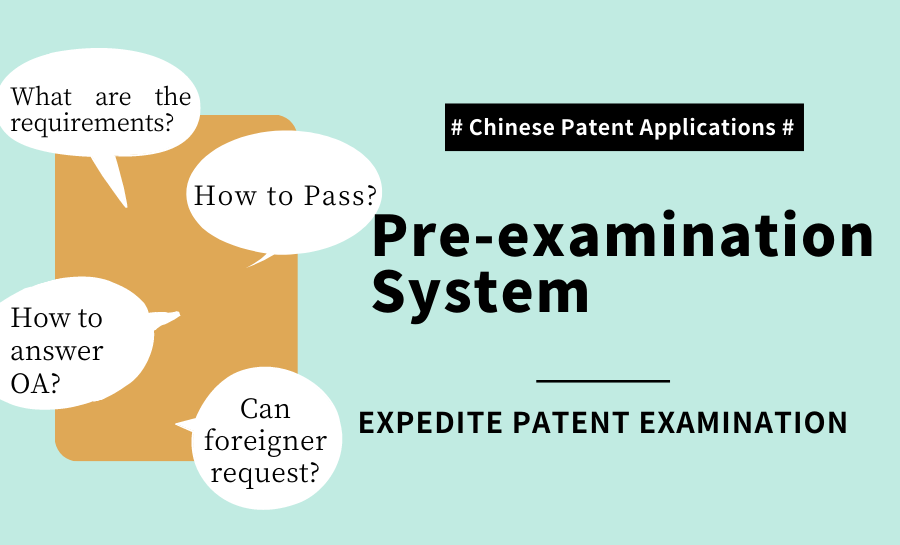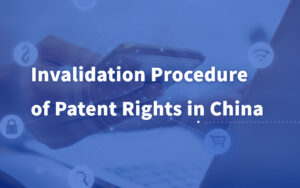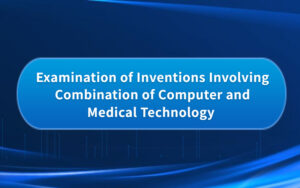Pre-examination System – Expedite Chinese Patent Examination
After filing Chinese Patent Applications, some applicants may want to expedite examination procedures of the patent application. We mentioned in our previous article that there are several ways for expediting the invention patent prosecution in China, such as Patent Prosecution Highway (PPH), prioritized examination system, pre-examination and request for early publication.

In this article, we will provide a more detailed introduction of the pre-examination system in China. This is a very effective way to expedite the patent examinaiton procedures in China.
From 2016, many intellectual property protection centers have been successively set up throughout China. These IP protection centers perform patent pre-examination services for patent applications. Applications that pass pre-examination can quickly enter the examination channel before the CNIPA.
1. Requirements for Requesting Pre-examination
In order to apply for pre-examination before an IP protection center in China, an application must satisfy the following four conditions:
a) The applicant should submit the pre-examination application to the proper IP protection center prior to formally submitting the patent application to CNIPA;
b) The registered address of the applicant must be in a location where an IP protection center is located;
c) The applicant has been recorded before the IP protection center; and
d) The application submitted must be within the technical field of the IP protection center.
It should be noted that different IP protection centers in China provide pre-examination services in different technical fields. Therefore, the applicant should check whether their inventions are within the technical field of a specific IP protection center.
2. Acceleration Effect
According to an official news release, the time to grant a patent application submitted to CNIPA after passing pre-examination can be shortened. It is about 3 months for invention patents; about one month for utility model patents; and less than 10 days for design patents.
3. How to Pass the Pre-examination – Quality Control
An application should pass the pre-examination in order to quickly enter the examination channel. The pre-examination mainly examines formality and obvious substantive defects. Poorly prepared application may fail the pre-examination procedure and then, fail to enter the fast track of examination.
In order to pass the pre-examination, we should enhance the quality of an application. In practice, we could pay more attention to the following aspects:
- Formal rules
- Quality of the specification
- Novelty and inventiveness of the claims
The first step is to check if the application has formal defects. For example, whether the drawings are clear? whether the claims use “wherein”? whether the reference signs are used properly? Such defects can be easily corrected and avoided.
Secondly, pre-examination has high standards regarding the quality of the specification. The specification’s support for claims, the logic of the specification and the description are all important aspects.
Finally, novelty and inventiveness of the claims are the most important. The requirements of novelty and inventiveness during pre-examination are the same as those during substantive examination. However, due to time limitation, the examiner will not strictly act in accordance with the Examination Guidelines. Generally, the examiner will list some references. And the claims of the application may be determined lack of inventiveness based on such references.
Different protection centers may have different rules during the pre-examination process. However, novelty and inventiveness of the application are generally the most important points for all protection centers.
Similar to the formal examination afterwards, the applicant has the opportunity to amend the application during the pre-examination. However, some problems may be easy to cope with, while some may be difficult. We will talk more about response strategies in the following parts.
4. Responses During Pre-examination
- Formal defects
Formal defects are easy to overcome. In most cases, the applicant can overcome such defects as long as he/she follows the examiner’s requirements.
- Quality of specification
Generally speaking, following the requirements of the examiner, it is not difficult for an applicant to overcome the defects of the specification. But sometimes, the examiner’s explanation regarding the rejection may not be so clear in the Notification. In such cases, the applicant may contact the examiner by phone to make more targeted response to examiner’s rejection.
- Novelty and Inventiveness
As was mentioned above, the examination procedure is not exactly the same with the formal substantive examination. Therefore, the response strategy may also be different. Based on our experiences, it is recommended to add new features, especially add new features in specification. It is helpful to overcome the objection during the pre-examination. In addition, when making responses during the pre-examination, the applicant is allowed to add new technical solutions in the specification and the claims. This method will increase the success rate of pre-examination. If the applicant is not sure whether new matter is allowed to add in the application, he/she may communicate with the examiner first.
And if the applicant is confused about the examiner’s question, he/she may call the examiner. Proper communication will help the applicant to make more effective response. Through communication, the applicant will have a better understanding of examiner’s standard regarding the quality of the application.
Though applicant may add new contents in the claims, the result of pre-examination is not binding. That is to say, the examiner during the formal substantive examination may have different opinions towards the application. For example, during the substantive examination, the examiner may consider that the application is allowable and the new contents added during the pre-examination was unnecessary. And in some cases, the examiner may not approve the amendment made during the pre-examination, and require the addition of other contents. In such cases, the new contents added during the pre-examination may become unnecessary features and restrict the protection scope of the final claims. In summary, pre-examination may have adverse effect on the protection scope of an application.
5. Can foreign applicant request for pre-examination?
It should be noted that the pre-examination system is not applicable for Chinese national phase entry application of a PCT international application. In addition, the registered address of the applicant (enterprise, university, or research institute) must be in a location where an IP protection center is located, and the application submitted must be within the technical field of the IP protection center. Therefore, if a foreign applicant wants to file a request for pre-examination, the applicant should have an entity registered in China.
As was mentioned above, different IP protection centers provide patent pre-examination services in different technical fields. For example, the Beijing Center mainly focuses on the fields of generating new information technology and high-end equipment manufacturing; the Shanghai Pudong Center focuses mainly on the fields of biomedical and high-end equipment manufacturing, and the Guangdong Center focuses mainly on the fields of new generation of information technology and biological industry. So, if a foreign applicant wants to register a company in China to be qualified for pre-examination, he/she should choose a place where 1) a protection center is located; 2) the technical filed of the protection center is close to the technical field of the company.
6. Summary
Pre-examination system can effectively shorten the examination procedures, but it has strict rules regarding the qualification of the applicant and the quality of the application. It is highly recommended that the applicant choose an experienced agency to ensure the quality of the application.

